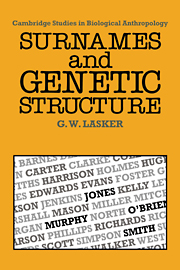Book contents
- Frontmatter
- Contents
- Preface
- 1 Introduction
- 2 History of surname studies in human biology
- 3 Sources of data
- 4 Methods
- 5 Isolates and inbreeding
- 6 Island versus distance models: the Far East and Oceania
- 7 The Americas and continental Europe
- 8 Scotland and Ireland
- 9 Regions of England
- 10 English cities and the general population of England and Wales
- 11 Specific surnames in Great Britain
- 12 Human population structure
- Literature cited
- Appendix maps and diagrams, of the distribution of 100 surnames in England and Wales
- Glossary
- Index
6 - Island versus distance models: the Far East and Oceania
Published online by Cambridge University Press: 05 November 2011
- Frontmatter
- Contents
- Preface
- 1 Introduction
- 2 History of surname studies in human biology
- 3 Sources of data
- 4 Methods
- 5 Isolates and inbreeding
- 6 Island versus distance models: the Far East and Oceania
- 7 The Americas and continental Europe
- 8 Scotland and Ireland
- 9 Regions of England
- 10 English cities and the general population of England and Wales
- 11 Specific surnames in Great Britain
- 12 Human population structure
- Literature cited
- Appendix maps and diagrams, of the distribution of 100 surnames in England and Wales
- Glossary
- Index
Summary
There are two types of model of the geography of population structure on which theoretical constructions are based: the island model and isolation by distance. Both have been used by population geneticists to model inbreeding in human populations. In actuality human populations tend to fit one or the other type of model better but almost always have elements of both. The island model assumes that individuals aggregate in tight clusters with essentially random mating within the cluster (‘island’) and with greater genetic differences from all other such clusters than among themselves. In this model the individuals share in the gene pool of their own ‘island’ in equal degree. This is a model which fits human isolates reasonably well and is implicit in most of the studies cited in the previous chapter.
The alternative model, of isolation by distance, assumes that space (conceived as a two-dimensional surface in the case of terrestrial organisms) is more or less evenly peopled by individuals whose ancestry and genetic constitution vary according to their position on the surface. The difficulty with this model when applied to humans is the obvious clustering of people in cities, towns and villages. In addition, genes and surnames are discrete entities with all-or-nothing occurrence. Since any point in space can have only one individual at it, the probabilities of occurrences at each point have to be calculated from other occurrences not at that point but considered relevant because of their spatial relationship to it.
- Type
- Chapter
- Information
- Surnames and Genetic Structure , pp. 38 - 42Publisher: Cambridge University PressPrint publication year: 1985

